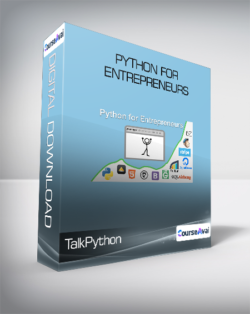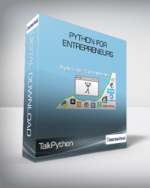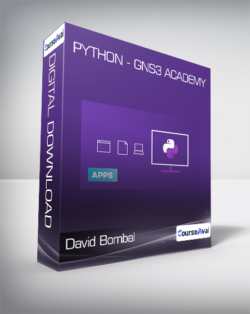Many courses will teach you about the technology involved in building a web application. Fewer courses will teach you what it actually takes to launch that product as an operating online business. Python for Entrepreneurs is here to teach you both how to build your website and everything needed to make it a functioning online business.Purchase TalkPython – Python for Entrepreneurs courses at here with PRICE $89 $32TalkPython – Python for EntrepreneursCourse SummaryHave you ever wanted to create a startup or small web-based business? Do you know a little of the Python language? Great, that’s a huge first step. But there are many elements to launching a successful online business and this course will fill in the gaps and help you realize your dreams.What students are sayingThe Python for Entrepreneurs course is so amazing. Thank you!— Stephen K.Source code and course GitHub repositorygithub.com/mikeckennedy/python-for-entrepreneurs-course-demosWhat’s this course about and how is it different?Many courses will teach you about the technology involved in building a web application. Fewer courses will teach you what it actually takes to launch that product as an operating online business. Python for Entrepreneurs is here to teach you both how to build your website and everything needed to make it a functioning online business.The overriding goal of this course is to dramatically shorten your time from idea to minimum viable product (MVP) to running in production and accepting online payments from months to weeks or even a couple weeks in some cases.When building an online product or web app, it’s easy to focus deeply on the product, the market fit, design, and these types of things. When you finally have it finished enough to launch your first version, you’ll find yourself hit with a wave of many unfamiliar technical tasks before you can actually go live:Accepting credit cards in a compliant mannerStoring user accounts in a ‘hacker-safe’ format to keep your product out of the headlinesSending outbound email (e.g. as a user makes a purchase or resets their password)Collecting users’ email for outbound email marketing (mailing lists)Domain registration and configurationSSL certificates and configurationError logging and monitoring in productionDeploying to cloud serversConfiguring your cloud servers for scaleTesting your website performance and making it fasterGetting help via part time contractors so you can focus on product and growthAnd so much moreYou will learn all of these in this course: How to build a data-driven web app and launch it successfully.Once you launch, you’ll need to turn your focus to areas that, as a technical person, you probably have little experience with. So we will also coverDesignCapturing and engaging usersSEO basicsGrowth hacking basicsShowcasing your productsView the full course outline.You will learn to build and design your web appThis course will teach you how to build a data-driven web application in Python. We will:Build our web app with the Pyramid web framework, “the Python web framework that supports your decisions, by artisans for artisans.”Create and connect to our database using SQLAlchemy, the most popular data access layer in PythonLearn the core elements of web design including CSS and front-end frameworks such as Bootstrap.What app will we build and explore?We will start from absolute scratch: a new, blank web app. From there we will build the ecommerce site for my and your favorite fictional, tech-based rock band “Blue Yellow Rockets”.Here’s a picture of the web application we’ll build during the course.What we will build: Blue Yellow Rockets webappA few things to note right from this screenshot:The design is catchy and feels pretty modernIt has account management (via sign in / register)Credit card and ecommerce capabilities under the albums nav linkMailing list / subscription support via ‘get notified’ fieldAnd that’s just above the fold. It has all the features we’ve discussed so far and much more.What is covered in depthEstimated length: 15 hoursAverage length of chapter: 45 minutesLectures per chapter: **5-10 video lecturesChapters: See course outline belowWho is this course for?The ideal student for this course is someone who knows a little (or a lot) of programming and wants to launch an online business based around a non-trivial product.For example, if you have always spent your time in middle-tier programming at a big company and you want to break out of that mold to launch a competitor to AirBnB, then you found the right place to start. That would be a huge challenge, of course, but it gives you the idea of who we have in mind.If you don’t know Python, consider taking my Python Jumpstart by Building 10 Apps course first.If you don’t know any programming at all, you’ll want to take a primer first. We recommend you take the free MIT course Introduction to Computer Science and Programming Using Python. Once you’ve learned the core computer science ideas you’ll be ready to dive deeper into Python with my two courses (jumpstart course and entrepreneurs course).Keep in mind, this journey you are starting is not necessarily (or even recommended to be) a leap before you look experience. You don’t have to quit your job, build an MVP, and see if the market or VC community wants it. Even if you just want to build something small as a side business first, this course would be perfect for you.Why Python?A premise of this course is that you want build something special. While many web apps can be constructed from a wordpress instance and a bunch of plugins plus a premium theme, you won’t really control that application.You will need to make the changes and tweaks to create a truly custom web app that can adapt as you get customer feedback after launch or to new business models. We want you to have an application that you can build upon for a long time to come. This means you need a custom app and Python is one of the very best choices for this.Pick and choose how you take this courseWe understand everyone comes with a different background and might need something different to succeed. Remember, the overriding goal is to get you from where you are to launch as fast as possible. Towards that end:This course is designed for random access.Let’s say you already know Python web apps, but don’t know much about front-end design or accepting credit cards. That’s fine, save the time, skip the web and database sections, just go from intro to web design basics to the credit card section.Already know web design but need the Python web exposure? Perfect: jump right into the Pyramid and Python parts.What if I use Flask or Django or even another tech?If you use another web framework such as Flask or Django, don’t worry. Almost everything we cover outside of explicitly covering Pyramid itself will be very relevant to you.For example, we’ll use Stripe Checkout for credit cards. This is basically the same across all three frameworks. We’ll use Mailchimp for mailing lists and email marketing. Again, it’s “pip install mailchimp” and carry on the same way across all three frameworks, etc.Concepts backed by concise visualsWhile building apps and learning as you go is engaging, it can be hard to fully introduce a topic in that format. That’s why when we hit a new topic, we stop and discuss it with concise and clear visuals.Here’s an example for when we will start working with Stripe and credit card processing.Example: Concepts backed by concise visualsBacked by real experience and successMichael and Matt have built a number of online web applications and launched them to varying degrees of success.Michael’s businesses (the podcast, related website, and online training website – where you’ll take this course) have done extremely well since they launched over four years ago.The Talk Python To Me podcast has over 17 million downloads and sponsorships are sold out through 6 month in advance. The courses are popular and continue to attract new and returning students. You will get a deep look inside these two web apps. During the course, you’ll see the internals, including source code, of how these apps work and some of the growth hacking techniques Michael has used to make them successful.Matt’s Full Stack Python (open source) project has helped over a million readers learn programming, web development and application deployment since it launched in December 2012. Today, over 75,000 people per month read Full Stack Python and contribute back to the project by submitting pull requests and opening issues on GitHub.Matt also inspires and equips fellow Python and Swift developers as a Twilio Developer Evangelist via his technical tutorials as well as in person at conferences and hackathons.And, of course, we’ve both tried a number of ventures that failed too.As much as possible, we will bring this experience to this course. We want to help you learn from what has worked for me and what hasn’t.Follow along with subtitles and transcriptsEach course comes with subtitles and full transcripts. The transcripts are available as a separate searchable page for each lecture. They also are available in course-wide search results to help you find just the right lecture.Each course has subtitles available in the video player.Who we are and why should you take our course?Meet Michael Kennedy:Who is Michael Kennedy?My name is Michael, nice to meet you. 😉 There are a couple of reasons I’m especially qualified to teach you Python.1. I’m the host of the #1 podcast on Python called Talk Python To Me. Over there, I’ve interviewed many of the leaders and creators in the Python community. I bring that perspective to all the courses I create.2. I’ve been a professional software trainer for over 10 years. I have taught literally thousands of professional developers in hundreds of courses throughout the world.3. Students have loved my courses. Here are just a few quotes from past students of mine.“Michael is super knowledgeable, loves his craft, and he conveys it all well. I would highly recommend his training class anytime.” – Robert F.“Michael is simply an outstanding instructor.” – Kevin R.“Michael was an encyclopedia for the deep inner workings of Python. Very impressive.” – Neal L.Meet Matt Makai:Who is Matt Makai?Hey there, my name is Matt Makai, thanks for considering my course! I’m stoked to teach this course for several reasons:I’ve been a professional software developer for over 15 years which has shown me how rewarding and empowering it is to create software for your own purposes.In 2012 I started Full Stack Python as a side project to help junior developers on my team learn how to build web applications with the Python programming language. This course is a natural extension of what is provided on Full Stack Python, with step-by-step instructions so anyone can build their own application even without prior programming experience.Get TalkPython – Python for Entrepreneurs downloadAs part of the Twilio Developer Network, it’s my goal to inspire and equip fellow software developers. Even if you don’t consider yourself a developer, it’s absolutely possible to build what you want if you’re willing to take some of your own inspiration and put it into learning from hands-on videos that equip you to code.Free office hours keep you from getting stuckOne of the challenges of self-paced online learning is getting stuck. It can be hard to get the help you need to get unstuck.That’s why at Talk Python Training, we offer live, online office hours. You drop in and join a group of fellow students to chat about your course progress and see solutions via screen sharing.Just visit your account page to see the upcoming office hour schedule.Is this course based on Python 3 or Python 2?This course is based upon Python 3.7. Python 2 now unsupported in 2020, we believe that it would be ill-advised to teach or learn Python 2. Moreover, the latest async features are only available in Python 3.5 or above.The time to act is nowBecome the Python developer you have always wanted to be. Join this course right now.Questions? Send us an email: [email protected]Course Outline: Chapters and LecturesWelcome to the course22:43Welcome and thanks for coming5:15Meet your instructors2:16What you’re going to learn4:26Built for random-access3:26What we are going to build1:24Corporate backers and deals3:51Video player: A quick feature tour2:05Course setup and tooling12:41What do you need to take this course?1:41Course setup on OS X3:11Course setup on Windows3:59Course setup on Linux3:50Python language refresher18:05Refresher Intro1:39Demo: Memory game – Structuring the program5:28Demo: Memory game – Implementing the game10:17Concept reviews are at the end0:41Build web apps with Pyramid: Part 11:02:47What can you build with Python?3:06Spectrum of frameworks2:04Web Framework Performance2:36Pyramid principles2:35CLI Introduction3:36CLI Demo6:27CLI Concepts3:31PyCharm Demo4:40PyCharm Concepts1:22Template variations / inconsistencies2:11Project Structure3:46Running Pyramid in PyCharm Community Edition4:53Introducing Pyramid Building Blocks1:34Building Block: Views2:28Building Block: Routes2:56Building Block: config1:19Building Block: Models0:47Building Block: Templates1:56Managing outside dependencies2:25Installing with bower6:32Concept: Bower1:32Get the back story0:31Source Control and Git41:56Source control concepts1:06What is Git?1:35Installing Git2:18First time git configuration2:56Using the Git CLI6:40Git Repositories3:34Introducing GitHub3:36GitHub signup settings4:54Asymmetric key overview2:51SSH Key Management in Linux and macOS2:57SSH Key Management in Windows2:42Adding SSH keys in GitHub1:39Creating git repositories2:38Cloning repos in Git2:30Digging Further into Git36:38Working with Git1:27Git status1:59Git Staging and Committing4:47Git add2:05Git commit4:08Git remote2:46Git push2:06The Git commit log3:02Collaboration on GitHub3:05Modifying files on GitHub3:40Git pull2:09Desktop Apps for Git: Sourcetree3:08Additional Git resources2:16Web design foundations1:09:24Design intro4:58The power of css3:02CSS Further Reading0:34Style-sheet overview5:35Cache busting: Introduction2:45Cache busting: The demo4:43Cache busting: the solution8:03Concept: Cache busting2:06CSS: Selectors demo5:24CSS: Selectors concepts1:42CSS: Box model demo4:53CSS: Box model-concepts2:20CSS: Layout demo intro1:15CSS: Layout Demo6:22CSS: Floating demo3:51CSS: Floating Concepts1:34Browser Dev Tools6:55CSS What’s Not Covered3:22Build web apps with Pyramid: Applied web development1:50:28Intro to applied web development4:01Demo: Remember the site we built? It’s back!2:09Introducing Pyramid handlers: Classes as controllers2:44Installing Pyramid Handlers2:11Concept: Controller classes via Handlers3:08Getting started with handlers demo4:07Mapping routes to controller actions demo5:51Concept: Mapping routes to controller actions1:39Leveraging a base controller demo3:16Concept: Base controllers1:08Plugging leaky actions demo3:35Concept: Plugging leaky actions1:39A peek inside Talk Python5:07Introduction to Chameleon templates1:05Concept:Template introduction1:05Data flow from controller to template demo3:45Styling the list views of data4:38Navigation based on logged in status and demo wrap up3:25Concept: Shared layout (motivation)2:15Shared layout demo8:16Concept: Shared layout3:13Concept: Project structure with layout0:34Concept: Anatomy of an HTML form1:46Concept: GET-POST-Redirect pattern2:20Register on the site (handle GET section) demo5:10Register on the site (handle post section) demo2:51Register on the site (data from post section) demo2:19Register on the site (redirect or error section) demo3:46Register on the site (handle errors section) demo3:44View models demo (intro section)4:11View models demo (reading data section)6:24Concept: View models3:30Concept: Server-side validation with view models1:10Client-side validation demo3:32Concept: Client-side validation0:54Web design: CSS Frontend frameworks and Bootstrap2:02:57Front-end frameworks introduction2:27Front-end framework Survey2:47Introduction to bootstrap9:15Installing bootstrap (recap)1:35Grid layout benefits2:14Grid layout demo6:05Buttons in Bootstrap5:21Images in Bootstrap7:09Introduction to navbars0:48navbars demo8:05Dark navbars and overriding bootstrap2:26Concept: navbars0:48Introduction to Bootstrap forms1:48Demo: Bootstrap forms in action4:23Concept: Bootstrap forms1:16Introduction to Dialogs in Bootstrap1:39Dialogs in Bootstrap Demo3:52Concept: Dialogs in Bootstrap1:24Introduction to Bootstrap Themes1:11Survey of Bootstrap Themes7:27From theme to Blue/Yellow2:33Mix in the theme11:37Make the theme fit your layout8:36Adding our copy and content4:23Newsletter section2:39Upcoming events section2:45Band members section3:22A proper footer4:24Incorporating a theme: wrap up3:31Alternating rows via an HTML helper in the view7:07Accessing databases from Python: SQLAlchemy ORM1:12:50Introduction to SQLAlchemy3:35Popular deployments2:18Concept: SQLAlchemy architecture2:27Demo: Part 1 Creating the engine and base class7:21Demo: Part 2 Modeling albums and tracks3:58Demo: Part 3 Creating the tables8:26Demo: Part 4 Relationships5:25Demo: Part 5 Indexes and nullability3:12Concept: Modeling classes with SQLAlchemy5:52Demo: Creating the Unit of Work2:13Demo: Reading data5:55Demo: Web form for creating albums and tracks2:13Demo: Creating albums and tracks10:35Demo: Review of creating albums0:54Concept: Unit of Work Design Pattern1:44Concept: Querying data4:40Concept: Adding new data1:26Going deeper with SQLAlchemy0:36Building your email list33:32Introduction to mailing lists2:29Choosing a mailing list provider4:33Creating your mailchimp account4:09Storing your API keys in your web app4:16Form to handle the sign up request4:50Using the MailChimp API8:19Concept: The MailChimp API3:36Concept: Sending mail1:20User accounts and identity1:04:04Accounts introduction1:37Demo: Account class6:36Concept: Account class2:18Demo: Account table creation1:05Demo: Account object creation8:03Demo: Hashing passwords12:08Concept: Hashing passwords1:36A peek inside Talk Python accounts2:51Introduction to login in and out0:59Demo: Getting started with logging in8:45Demo: Reading the authentication cookie4:57Demo: Making the cookie tamper-proof2:09Demo: Indicating the signed in status2:03Demo: Logging out4:11Concepts: logging in3:05Concept: Logged in status1:41Sending and receiving email1:14:56Introduction to sending outbound email2:27Demo: Setup for sending email5:14Demo: Sending basic HTML email6:05Demo: Sending the welcome message (basic)4:15Concepts: Sending basic email3:30Demo: Sending rich templated email12:09Concepts: Sending rich templated email2:09Inbound email on your own domain name4:20Introduction to password resets5:33Demo: Setting up password resets3:02Demo: The password reset table2:50Demo: Creating resets6:01Demo: Emailing the reset code2:02Demo: Performing the reset6:10Demo: Setting the password7:12Concept: Password resets1:57SEO and Content Marketing38:21Search Engine Optimization (SEO) foundations4:16Content examples10:46Content titles and headers3:24Meta descriptions3:38Content length4:46URL structure2:28Site speed6:48HTTPS and Mobile Browser Support2:15Deploying to the cloud1:49:51Introduction to deployment2:34Hosting6:08Using Ansible5:18The initial configuration22:53The deployment playbook7:26Domain names3:56Let’s encrypt11:26Deployment map5:54Using nginx as our web server9:47git-ting our source code9:20Application dependencies7:14Supervisor waitress5:50Setting up notifications9:23Updating resources2:42Making money (credit cards and businesses)1:07:43Making money introduction4:53Accepting credit cards options2:33Stripe Checkout overview3:26Demo: Checkout skeleton4:14Demo: Adding checkout javascript11:35Concept: Checkout JavaScript2:21Finalizing the purchase9:43Calling the Stripe API8:09Concepts: Finalizing the purchase2:02Business structures4:29US companies for people outside the US1:16Sales and pricing models5:51Purchase orders3:53The story of Stratechery3:18Monitoring and logging in production1:05:07Introduction to logging and monitoring3:18Introducing logbook: better logging than builtins4:09Creating the logging skeleton structure6:12Integrating logbook into our app10:56Logging dependency versions at startup4:58Logging made easy inside web action methods5:59Concepts: logbook3:52Introduction to Rollbar: Monitoring in production1:52A peek inside Michael’s Rollbar account6:31Creating your Rollbar app10:12Setting up notifications in Rollbar4:05Concepts: Monitoring with Rollbar3:03Getting help (contracting, design, and more)25:39Introduction to getting help4:02Hiring contractors via Upwork0:50Inside Michael’s projects at Upwork3:12Upwork: Reviewing the applicants4:03Upwork: A cautionary tale on hiring1:48Premium graphic design via 99designs1:30Python Bytes at 99designs6:16A little help for five dollars1:07Inside Michael’s projects at fiverr2:51Growth hacking basics26:10Growth hacking marketing4:50Turkey carving3:39Email campaigns2:49Open source3:44Calls to action4:44Pricing pages6:24Course Conclusion38:12You’ve done it!0:47Showcase (of student creations)0:40Lightning review: pyramid-building-blocks1:48Lightning review: git1:11Lightning review: web-design-foundations2:08Lightning review: applied-pyramid1:41Lightning review: css-frameworks2:08Lightning review: sqlalchemy2:24Lightning review: mailing-list1:15Lightning review: Accounts2:08Lightning review: Sending email1:02Lightning review: SEO3:04Lightning review: Deployment1:04Lightning review: Credit cards1:44Lightning review: Monitoring2:46Lightning review: Getting help0:58Lightning review: Growth hacking3:32Get and update the source code1:19The final Pyramid cookiecutter template5:54Thanks and bye0:39Appendix: Python language concepts46:01Concept: The shape of a program1:15Concept: Variables0:51Concept: Truthiness1:47Concept: If else1:24Concept: Complex conditionals1:31Concept: for-in1:41Concept: Calling functions0:59Concept: Creating functions1:33Concept: File I/O1:20Concept: Imports and importing modules1:59Concept: Python package index1:54Concept: pip2:26Concept: Virtual environments3:53Concept: Slicing2:53Concept: Tuples1:43Concept: Named tuples1:44Concept: Classes2:01Concept: objects vs. classes1:44Concept: Inheritance1:30Concept: Polymorphism0:53Concept: Dictionaries2:30Concept: Error handling2:38Concept: lambdas2:09Concept: list comprehensions2:57Concept: Want more foundational Python?0:46Readmore: http://archive.is/u9XVQPurchase TalkPython – Python for Entrepreneurs courses at here with PRICE $89 $32
 Dan Sullivan – How to avoid the gap
₹4,648.00
Dan Sullivan – How to avoid the gap
₹4,648.00
 Mel & Amber Ross – Florida 16 Hr Hair Braiding Registration Online Course
₹3,154.00
Mel & Amber Ross – Florida 16 Hr Hair Braiding Registration Online Course
₹3,154.00
TalkPython – Python for Entrepreneurs
₹5,312.00






